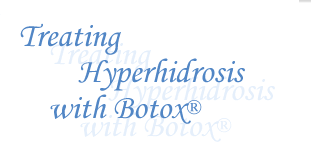Treating Hyperhidrosis with Botox®:
Facial, Palmer (Palms), Axillary (Underarms), Plantar (Feet)
Sweating is a natural function of the body needed to regulate temperature and the secretion of sweat is controlled by the nervous system. Throughout an average day, our bodies naturally perspire as a way to regulate heat. In some individuals, natural perspiration is excessive, the eccrine glands are over-stimulated and sweat is produced beyond what is necessary to cool the human body; this condition is referred to as primary hyperhidrosis (secondary hyperhidrosis involves the entire human body).
With approximately 5 million sweat glands spread over the human body, approximately 2/3 of these glands are located in the palms. Primary hyperhidrosis may occur in the hands, feet and armpits – anxiety and nervousness can precipitate excessive sweating.
Sweating on the face can also be quite severe and causes insecurity and anxiety in the individual concerned. Patients can also experience extensive facial blushing. The most distressing case of hyperhidrosis is sweaty hands. The amount of sweating varies from moisture, clammy palms to dripping, where the individual constantly wipes his/her hands. Anxiety also manifests itself during social or professional settings and individuals can be reluctant to shake hands or even avoid holding hands with their loved ones.
Excessive hand sweating can be quite severe and in about 40% of individuals, this problem is genetically related. Palmer hyperhidrosis normally starts in childhood and can get more severe in later years. Axillary hyperhidrosis can be very embarrassing with obvious wet marks on shirts, t-shirts or odor. Odor can also be apparent for those suffering from plantar or axillary hyperhidrosis, but this is mostly generated by bacteria on the skin if the sweat remains on the epidermis for a long time.
What can you do about Hyperhidrosis?
- Choose clothing that keeps you cool and keep sweat away from your body and feel dry.
- An environment that is cool and well aired is preferable.
- Avoid foods and drinks that trigger sweating (i.e.: hot or spicy foods/drinks, smoking). There are different triggers for everyone but you probably know what these are, including strong emotions.
- Try to reduce your stress and anxiety. Individuals with hyperhidrosis are easily affected and can trigger the eccrine glands.
- Pay attention to personal hygiene (frequent hand washing, showers, etc): it is an effective and simple measure to take to reduce bodily odors.
Treatment options for Primary Hyperhidrosis?
- Antiperspirants with aluminum chloride.
- Iontophersis (low intensity electric current to hands and feet immersed in electrolyte solution – repetitive several times a week).
- Surgery (endoscopic thorascopic sympathectomy: cutting the nerves that transmit signals to sweat glands).
- Axillary sweat gland removal: for excess armpit sweating only. Scars may follow surgery, restricting shoulder motion.
- FDA approved botulinum toxin injections (Botox™).
The simplest treatment is usually recommended first, and should the individual not see results as quickly as they like, they move on to either surgery or Botox™ injections.
How does Botox™ work?
- Using a very fine needle, the patient is injected with a small amount (0.1 to 0.2 ml solution) of Botox™ into 10 to 15 places about 1 cm apart and spread evenly. Once injected, Botox™ interferes with the nerve conduction that the supply eccrine glands: this prevents the glands from producing sweat. If you notice that some sweat glands were missed, you may continue to experience some sweating from the untreated areas.
- In low doses, Botox™ is injected either in the face, neck, palms, feet or underarms to treat hyperhidrosis by temporarily paralyzing the sympathetic nerves that cause sweating.
- Treatment has to be repeated two or more times per year as the effects “wear off”.
- If you do not see a significant reduction in sweating, please schedule a follow up with your physician.
How long does it last?
- The patient notices some change for the better within the first week of treatment with a noticeable improvement over the next few weeks. The effects usually last several months (approximately 6 – 7 months). Do not wait until the full effects wear off before you proceed with another treatment. If you are uncertain, schedule another appointment with your physician as soon as possible.
- Individuals vary greatly and have different responses to treatment. The average reduction in sweat production after the first week of treatment was 87% and sweating was reduced by 95% of patients in case studies.
Possible side effects?
- Some redness and/or tenderness at the injection site.
- Possibility of swelling at the treatment site: this normally disappears fairly quickly.
- Possibility of bleeding or complete lack of underarm sweating.
Permalaser advises you that just with any medical procedure, the choice to receive injections should always be well thought out and discussed. What if I decide to stop the Botox™ injections? If you decide to stop Botox™ treatments there will be no lasting change in the treated areas and sweating will gradually return to its regular level prior to your starting Botox™ treatments. Excessive sweating from Hyperthyroidism, endocrine treatment for malignant diseases, obesity and menopause can be related to secondary hyperhidrosis. Please see your physician for additional information. Is this procedure covered by Medicare? Botox™ treatments for hyperhidrosis are not covered by Medicare. Please verify with your insurance company or company health plan to see what percentage (if any) of costs can be covered.Most Insurance companies will cover costs for treatment of Hyperhidrosis. Treatment is tax deductable.
Contra-indications: for all injectable products for lactating or pregnant women.




